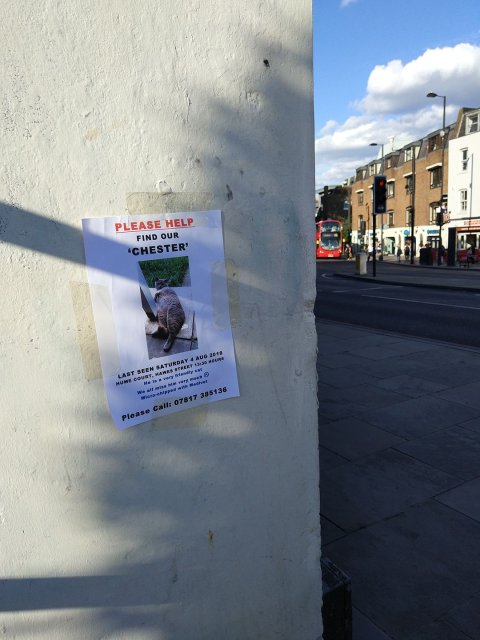
A killer is stalking the streets of England, taking more lives than Jack the Ripper, Ted Bundy and John Wayne Gacy combined. Police, pathologists and amateur investigators are scrambling to solve the case as mutilated bodies pile up between winding rows of terraced houses, parks and even schools—more than 500 at the latest count.
The victims are not people; they all walk on four legs: Foxes, rabbits and hundreds of cats. After each is bludgeoned, the killer slices off trophies, often taking the head, the tail or a paw. The bodies, or just the dismembered parts, are then displayed in places children are sure to find them—in front of homes, in the family rabbit hutch or, in one case, outside the gates of a school.
While no one knows for sure, the attacks appear to have begun in 2015. That's when London tabloids began covering the killings, eventually dubbing the assailant the U.K. Cat Killer. A series of postmortems by a specialist vet in the early days of the Metropolitan Police's investigation confirmed how the animals were killed, but they have yet to come up with a suspect. In August, a new body turned up almost every day, but with no witnesses, closed-circuit TV footage or traces of DNA, there isn't much to go on.
Boudicca Rising and Tony Jenkins launched their own investigation in 2015. The animal rescue volunteers, based in South London, began to notice a series of bizarre animal deaths on Facebook. Cats were turning up mutilated in the borough of Croydon. "One had a slash down its tummy, another across it neck," says Jenkins. A third had been decapitated. They began stringing the case together on their own, determined to find out if the murders were messy accidents or a sign of something more sinister.
Scotland Yard began investigating the crimes in November 2015, under Operation Takahe. But outside of London, Rising and Jenkins perform much of the legwork. As word of the crimes spread, bodies started popping up hundreds of miles beyond the capital: Liverpool, Sheffield, Brighton.
I meet the couple in late June, in the middle of a heat wave. Red-haired and resolute, Rising shares her first name with a Celtic queen who led an uprising against the Romans. Rising spent her early years at protests with her anti-apartheid parents in South Africa. In London, this translated into performance art–style protests against the sale of fur coats. After meeting the soft-spoken Jenkins, she encouraged his own animal rights activism. On the odd weekend when he's not chasing the cat killer, he acts as a "hunt saboteur," bamboozling the countryside elites that set bloodthirsty hounds on the trail of local foxes.
I accompany the two on a three-hour trip from London to the port city of Southampton, where a local vet had reported two possible killings earlier that month. When we get there, a young woman unwraps the corpse of a cat from a plastic sack; although it has been refrigerated, a putrid smell fills the room. Clutching tissues to their faces, the couple examine the body. Noting so-called "signature injuries"—like the cuts to the fur, showing the tail was sliced, not ripped—they quickly conclude the animal was a victim of their killer. They send photos to the police and mark the body for cremation.
Cat People Times Ten
Rising and Jenkins set up South Norwood Animal Rescue and Liberty, or SNARL, in 2014; they run it out of their homes. Nearly four years later, Jenkins says, they see more dead cats than living ones.
SNARL's social media accounts have become the pair's greatest tool for investigation, allowing them to assemble a team of hundreds of volunteers, many of whom, Rising says, are "as determined to catch this sick fuck as we are." They track the killings on Facebook, share information appeals on Twitter and drop leaflets in neighborhoods where the killer strikes. Jenkins thinks they've delivered more than a million flyers. Armed with cigarettes and coffee, they sift through hundreds of emails, texts and Facebook messages every week, responding to almost everything—words of support, earnest but often misguided tips, even mail from psychics.

Outside London, Rising and Jenkins struggle with fractured local police forces that often refuse to give them an ear. Many officers, they say, have been hard to win over in the face of ever-tightening department budgets and, of course, crimes against humans. As a result, the two have assumed the roles of detective and pathologist—attending crime scenes, consulting vets, even storing bodies in their freezer—in addition to family counselor, comforting the owners of dead pets. Over time, says Jenkins, they've also become better at eliminating false positives, discounting many more cases than they confirm.
There are those who accuse the media of peddling a sensational tale of a killer that doesn't exist. The Royal Society for the Prevention of Cruelty to Animals was among the skeptics—at least at first. The charity tells Newsweek that when it comes to mutilated animal bodies, fellow wildlife is often to blame. But the RSPCA is now reviewing evidence gathered over the past two and a half years.
Still, skeptics remain. "When members of the public go, 'You're making it up,' I get that completely," says Rising. "It's so horrifying, you don't want to think a person is doing this."
Building a Profile
Serial animal killers aren't rare, but the U.K. Cat Killer's particular brutality is. Someone is killing dogs in Hong Kong, but that person's weapon of choice is poison, which doesn't require hands-on violence. Cases this relentless are practically unheard of, says Sam Poyser, a criminologist at York St. John University. "I don't think the U.K.'s experienced anything like it," she says. "If you were going to come up with the most horrific animal murder story, you couldn't come up with this."
The killer—or killers—likely fits into a small but specific psychological group, says Poyser: "The most sadistic acts of cruelty are now associated with individuals who have low levels of neuroticism—in other words, they're cool, calm, collected personalities." It's also likely it is a man—the gender of most animal abusers. Homicide expert Kenna Quinet of Indiana University-Purdue University Indianapolis thinks he's a misogynist too. Cats, she says, may stand in for women who have rejected his advances. Instead of trying to change his luck, he wallows in misogyny and lashes out. "We see this adaptation strategy everywhere—with serial killers, mass murderers, school and workplace shooters."

There is a classic profile of serial killers, where a man begins torturing animals as a child or adolescent, then graduates to people. Poyser doesn't believe that's true here; the crimes have been going on for too long, and too persistently. More likely, she says, the killer is already harming humans—albeit in less dramatic ways—or committing low level offenses; she suspects his DNA may be in the country's database. Quinet agrees: "Most people who abuse animals also engage in other antisocial behavior."
Animal abuse is strongly linked to domestic violence. If the killer has a partner, Poyser says, that person may be a victim of his aggression. To acquaintances, however, he probably seems normal. Quiet, perhaps, but easy enough to get along with.
Though his motives are unknown, the crimes are certainly aimed at the humans who own the pets that are killed, says Poyser. Leaving trophies to be found by unsuspecting owners prolongs their shock. Cats, after all, are members of the family.
Pets Get No Respect
When it comes to murdered pets, the arm of British law is short, says Sean Brunton, an Exeter-based lawyer who specializes in animal welfare law. "The Cat Killer case is a very good illustration of a [hole] within U.K. legislation."
Killing a cat isn't normally considered a crime in and of itself. If a stranger knocks over your dog or a neighbor drops your hamster, they probably won't face legal action. But if you kill an animal deliberately, you might be charged under the country's Animal Welfare Act. "Whether an animal is stabbed or deliberately run over, it's hard not to cause unnecessary suffering," Brunton says. "If you do it knowing or suspecting that suffering would be caused," he says, "then potentially you could be prosecuted." But, he adds, you have to be seen to be committing the crime.
The most disturbing aspect of the Cat Killer case—the unsettling mutilations—take place long after the killer bludgeons the victim, making it essentially irrelevant in terms of animal welfare law. With the right evidence, police might be able to swing harassment, public order or criminal damage offenses. But, says Brunton, the nature of the crimes means the accused would face magistrates in a lower court—one with punishments limited to fines, community service and prison sentences no longer than a year.
In August, the U.K. government announced it would increase the maximum sentence for animal abuse to five years for the worst offenses. "The reality, however, is that the courts do not take offenses against animals seriously enough," says Brunton. "If you're a serial animal killer, you can pretty much do it with impunity."

Welfare laws regularly fail U.K. animals. Farmers and breeders, Brunton says, let animals die every day. Creatures under human care are neglected, starved and outright killed, with their owners rarely punished. The RSPCA—the world's oldest animal-welfare charity, founded in 1824—investigates almost 150,000 cases of animal cruelty a year, and Poyser suggests the real number is probably much higher.
The severest sentence would likely come via a jury of average Brits. The U.K. is a self-professed "nation of animal lovers." This phrase is tossed around as fact, but it has a solid basis in reality; there are almost as many pets as people. But welfare law is clearly out of step with the average citizen. For example, the public overwhelmingly decries fox hunting with dogs—a blood sport banned, with exemptions, in 2004. But politicians regularly try to alter or repeal the ban, seeing hunting as a stalwart part of rural life. And, just last year, members of Parliament failed to pass an amendment that would have seen "animal sentience" enshrined in U.K. law, as it is within the European Union's Lisbon Treaty.
But trial by jury is unlikely, even in a case as sensational and brutal as the U.K. Cat Killer. Animal crimes—even the most shocking—rarely if ever make it to higher courts.

Animal cruelty laws are equally difficult to enforce in the U.S. "There's state laws or county laws, and then there's local laws that all inform how these acts are dealt with," Danielle Bays, community cats program manager at the Humane Society of the United States, tells Newsweek. Both state and felony laws cover animal cruelty, but figuring out who enforces the rules gets complicated; connecting and solving cases across different cities and states can therefore be tricky.
In Washington state, police have confirmed there is a cat killer; at least 13 remains have been found since February, many of them bearing an eerie resemblance to the U.K. victims. "The mutilated remains of beloved pets have shown up in public places around Olympia—on front lawns, in neighborhood parks, even on the grounds of a church," The New York Times reported in August. "Even if apprehended," says Quinet, the killer's "punishment would be minimal," a misdemeanor with no jail time.
Back in the U.K., the search for the Cat Killer could be nearing its end, at least as far as the Metropolitan Police are concerned. When Newsweek requested an update from the authorities, the response indicated that officers were bringing the case to a conclusion. In addition, the word alleged was next to "cat killer," implying that they no longer believe a serial killer is to blame. Or they could simply be giving up.
For Rising and Jenkins, it isn't over until the killer is found—even if, after three years, they're "bloody exhausted," Rising says. "If we'd known at the start how big the investigation would turn out, I'm not sure if we would have carried on." Jenkins quickly objects: There's no way they would have given up. "You're right," she says. "We would have stuck it."















